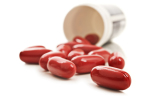- FreeTrainers.com Forums
- Health Supplements
- Creatine Explained
Group: Health Supplements
Created: 2012/01/01,
Members: 101,
Messages: 16612
Supplements can be a great aid with your health and fitness goals. Combined with the proper exercise and nutritional plan they can be quite effective.
Join group
 Creatine Explained
Creatine Explained

Carivan
Posts:
8,542
Joined: 2002/01/20  |
2006/02/05, 12:42 PM
Thought I would post this for those interested:
Creatine Explained By Joseph M Warpeha, MA, CSCS, NSCA-CPT Most ethical exercise scientists and sport nutritionists would argue that the majority of supplements are a waste of money because they either: 1) do not have an ergogenic effect (i.e. enhances exercise/work capacity) or 2) do not do anything beyond what a well-balanced diet achieve. However, a few supplements appear to have withstood the test of time and research. Creatine is one of those few. Creatine was first introduced to the public as a nutritional supplement in 1993. The initial anecdotal claims revolved around an increase in muscular size and strength as well as reduced recovery times from anaerobic exercise/activity. After about 10 years, the majority of research agrees with this and the current consensus is that creatine supplementation has the greatest benefit for those looking to enhance high-intensity, short-duration performance (4). Examples of such activities would be a one-repetition maximum bench press, a 40-yard sprint, or any of the field events in track. The allure to recreational exercisers and strength-speed athletes alike is obvious. An understanding of the theorized benefit of creatine first requires a basic knowledge of what makes human movement possible. Simply put, the answer is ATP (adenosine triphosphate). It is the fuel that runs the human engine. One of the major purposes of the food we consume in the forms of fat, carbohydrates, and protein is to produce ATP. The secret of ATP lies in its high-energy chemical bond between the second and third phosphate groups. If you remember back to high school chemistry, when a bond is broken energy is released. The breaking of this third bond releases the energy that indirectly causes muscle contraction to occur. Once the bond is broken, the result is Pi (inorganic phosphate) and ADP (adenosine diphosphate), which has a much lower energy yield and is not a preferred source of energy by skeletal muscle. The body has enough stored ATP to sustain a few seconds of high intensity work, but then must rely on rapid resynthesis of ATP to maintain a high power output. Creatine phosphate is another high-energy phosphate compound that is stored in muscle cells (at a concentration three times greater than that of ATP) (3) and is used to re-synthesize ATP from ADP. The energy liberated from the splitting (hydrolysis) of creatine phosphate is then used to "re-bond" ADP and phosphate to form ATP (5). Creatine is an amino acid derivative. It is produced by the body in the liver, kidneys, and pancreas and is also supplied in the diet. The average person consumes about 1 gram of creatine per day in their diet and another 1 gram is produced by the body (8). The best sources of creatine in the diet are meat and fish (6). In the early 1900s, scientists in Russia discovered that consuming supplementary creatine enhanced certain muscle and performance parameters. The idea is that if more creatine is consumed, more is stored in the muscle and more creatine phosphate is therefore available for the rapid production of ATP needed during high intensity activities. Studies have shown that creatine supplementation increases the creatine phosphate content of the muscle by up to 20% (2) or more. In medium to low intensity activities that are longer in duration (more than a minute or two), ATP requirements are not as high because the power output is lower than that of short duration (< 30 sec), high intensity activity. With the longer duration activities, aerobic processes take over as the primary producers of ATP and the reserves and rapid resynthesis of ATP are no longer performance limiting factors. Most studies have shown that creatine supplementation has little or no benefit to aerobic performance (6). Dosages of creatine supplementation range anywhere from 1 – 2 grams/day to 20 – 30 + grams/day. Supplementation usually involves a preliminary "loading" phase (5 – 7 days) to initially boast creatine stores and then a "maintenance" phase to sustain muscular creatine levels. Loading dosages are usually in the range of 20 – 25 grams/day whereas the amount required to maintain the newly elevated levels is about 2 – 5 grams/day (8). Most agree that the body has a limit as to how much creatine it can store and that people consuming high amounts are probably just excreting the excess. Creatine is one of the few "supplements" that has demonstrated a positive ergogenic effect (9) but has not been banned by any major athletic sanctioning body like the IOC (International Olympic Committee) or NCAA. In short, it is not illegal for athletes in any sport to take creatine. Interestingly, creatine is banned in France. Since creatine has only been widely available to the public since 1993, it is impossible to determine what, if any, side effects may result from long-term creatine supplementation and what dosage levels may be dangerous. It should be noted that the effects of creatine supplementation on performance are dependent on the individual person and vary widely from non-existent to significant. While creatine use has been linked to diarrhea, dehydration, muscle cramping, and muscle strains, these side effects have been refuted by many studies (2). Reported weight gain associated with creatine supplementation may or may not be reflected in changes in hydration (1). Kidney damage is one of the theorized potential long term complications with creatine use. Chronic use of high doses of creatine has been associated with kidney damage in a few isolated cases (7,10). It would seem that the occurrences of side effects are as variable between individuals as the ergogenic effects are. The lingering question remains as to whether or not creatine is too good to be true. Only time will tell. Medical Note: FDA regulates dietary supplements under a different set of regulations than those covering "conventional" foods and drug products (prescription and over-the-counter). Under the Dietary Supplement Health and Education Act of 1994 (DSHEA), the dietary supplement manufacturer is responsible for ensuring that a dietary supplement is safe before it is marketed. FDA is responsible for taking action against any unsafe dietary supplement product after it reaches the market. Generally, manufacturers do not need to register their products with FDA nor get FDA approval before producing or selling dietary supplements. A licensed physician should be consulted before using any nutritional supplement. References 1. Baechle TR, Earle RW. Essentials of Strength Training and Conditioning, 2nd Edition. Champaign, IL: Human Kinetics. 2000. 2. Brooks GA, Fahey TD, Baldwin KM. (2005). Exercise Physiology: Human Bioenergetics and Its Applications, 4th Edition. New York: McGraw-Hill. 3. Fox SI. (2002). Human Physiology, 7th Edition. New York: McGraw-Hill. 4. Hoffman JR, Stout JR, Falvo MJ, Kang J, Ratamess NA (2005). Effect of Low-dose, Short-duration Creatine Supplementation on Anaerobic Exercise Performance. Journal of Strength and Conditioning Research. 19(2):260 – 264. 5. McArdle WD, Katch FI, Katch VL. (1996). Exercise Physiology: Energy, Nutrition, and Human Performance, 4th Edition. Baltimore, MD: Williams & Wilkins. 1996. 6. Paddon-Jones D, BØrsheim E, Wolfe RR (2004). Potential Ergogenic Effects of Arginine and Creatine Supplementation. Journal of Nutrition. 134:2888S – 2894S, 2004. 7. Persky AM, Brazeau GA. (2001). Clinical Pharmacology of the Dietary Supplement Creatine Monohydrate. Pharmacology Review 53:161 – 176, 2001. 8. Powers SK, Howley ET. (2004). Exercise Physiology: Theory and Application to Fitness and Performance, 5th Edition. New York: McGraw-Hill. 9. Volek JS, Rawson ES. (2004). Scientific Basis and Practical Aspects of Creatine Supplementation for Athletes. Nutrition. 20:609-614. 10. Wardlaw GM, Hampl JS, DiSilvestro RA. (2004). Perspectives In Nutrition, 6th Edition. Champaign, IL: Human Kinetics. About the Author Joe Warpeha is an exercise physiologist and strength coach and is currently working on his PhD in exercise physiology at the University of Minnesota-Minneapolis. His current research focuses on bone and tendon adaptations to training and the effects of skeletal loading on their physiological and mechanical properties. Joe teaches several courses at UM including "advanced weight training and conditioning" and "measurement, evaluation, and research in kinesiology". He has a master's degree in exercise physiology and certifications through the NSCA, ACSM, USAW, ASEP, and YMCA. He has over 14 years of resistance and aerobic training experience and has been a competitive powerlifter since 1997. Joe is a two-time national bench press champion and holds multiple state and national records in the bench press while competing in the 148, 165, and 181-pound weight classes. -------------- Scales are for dead weight: We are not dead yet! Still trying to find out how to do the Hollywood Free Press. Ivan Montreal Canada |
|
| |

jonnnyko
Posts:
108
Joined: 2004/01/19  |
2007/05/27, 10:13 PM
May seem like a stupid question, but what is the difference between Creatine CEE and the powder creatine? All I've heard it that some people seem to feel bloated from the powder. But are there more of a difference then just the form it comes in?-------------- Jonathan (jonnnyko@hotmail.com) *** Nothing Is Real but Pain Now *** |

JD88
Posts:
5
Joined: 2007/12/20  |
2007/12/23, 05:30 AM
Creatine CEE is changed in a lab so it disolves in the stomach better as normal creatine isn't very soluble. By disolving in the stomach it means more of it might make it across into the blood, i say might because if it is too soluble it will just stay in stomach.
|

Pensfan
Posts:
484
Joined: 2008/03/14  |
2008/04/02, 04:26 PM
drink lots of water it can dehydrate you too.
|
